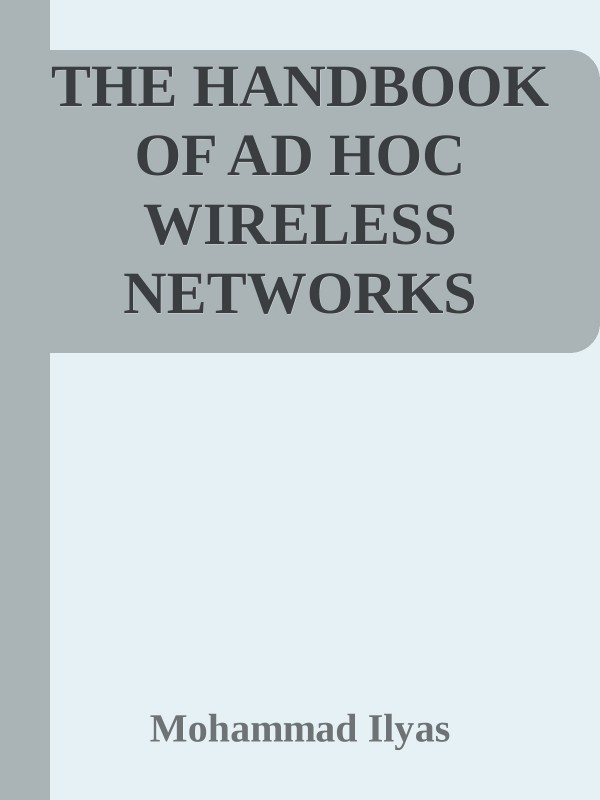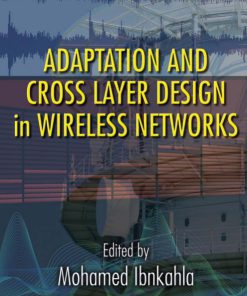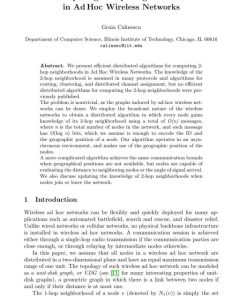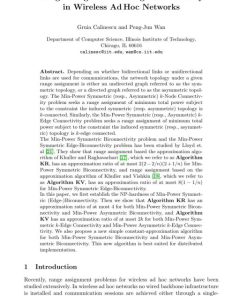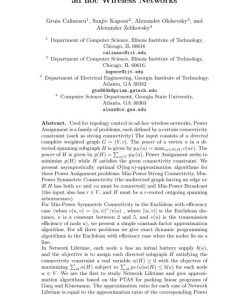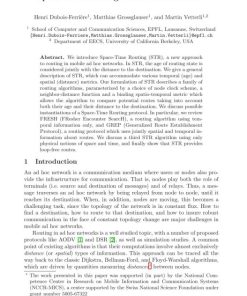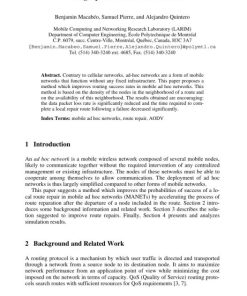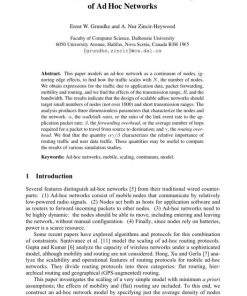THE HANDBOOK OF AD HOC WIRELESS NETWORKS 1st edition by Mohammad Ilyas ISBN 0849313325 978-0849313325
$50.00 Original price was: $50.00.$25.00Current price is: $25.00.
Authors:Mohammad Ilyas , Series:Electrical Engineering [33] , Tags:Electricity & Electronics , Author sort:Ilyas, Mohammad , Languages:Languages:eng , Published:Published:Aug 2004 , Publisher:CRC Press , Comments:Comments:Providing a one-stop source of information for the rapidly growing field of ad hoc wireless networks, this volume offers authoritative material on a broad range of topics, from the basic to research levels. It addresses potential uses and challenges of ad hoc wireless networks
THE HANDBOOK OF AD HOC WIRELESS NETWORKS 1st edition by Mohammad Ilyas – Ebook PDF Instant Download/Delivery. 0849313325 978-0849313325
Full download THE HANDBOOK OF AD HOC WIRELESS NETWORKS 1st editon after payment

Product details:
ISBN 10: 0849313325
ISBN 13: 978-0849313325
Author: Mohammad Ilyas
A relative newcomer to the field of wireless communications, ad hoc networking is growing quickly, both in its importance and its applications. With rapid advances in hardware, software, and protocols, ad hoc networks are now coming of age, and the time has come to bring together into one reference their principles, technologies, and techniques.
The Handbook of Ad Hoc Wireless Networks does exactly that. Experts from around the world have joined forces to create the definitive reference for the field. From the basic concepts, techniques, systems, and protocols of wireless communication to the particulars of ad hoc network routing methods, power, connections, traffic management, and security, this handbook covers virtually every aspect of ad hoc wireless networking. It includes a section that explores several routing methods and protocols directly related to implementing ad hoc networks in a variety of applications.
The benefits of ad hoc wireless networks are many, but several challenges remain. Organized for easy reference, The Handbook of Ad Hoc Wireless Networks is your opportunity to gain quick familiarity with the state of the art, have at your disposal the only complete reference on the subject available, and prepare to meet the technological and implementation challenges you’ll encounter in practice.
THE HANDBOOK OF AD HOC WIRELESS NETWORKS 1st Table of contents:
Preface
- Overview of the Book
- Motivation and Scope
- Intended Audience
- Acknowledgments
Chapter 1: Introduction to Ad Hoc Wireless Networks
1.1. What are Ad Hoc Networks?
1.2. Evolution of Ad Hoc Wireless Networks
1.3. Key Characteristics and Challenges
1.4. Applications of Ad Hoc Networks
1.5. Ad Hoc Network Types (Mobile, Static, Hybrid)
1.6. Design and Performance Considerations
Chapter 2: Wireless Communication Fundamentals
2.1. Basic Principles of Wireless Communication
2.2. Frequency Spectrum and Wireless Channel
2.3. Signal Propagation and Path Loss Models
2.4. Modulation and Coding Techniques
2.5. Interference and Noise in Wireless Networks
2.6. Multiple Access Methods in Wireless Networks
Chapter 3: Ad Hoc Network Architecture
3.1. Network Topology in Ad Hoc Networks
3.2. Peer-to-Peer and Client-Server Architectures
3.3. Routing Protocols and Their Classification
3.4. Centralized vs. Decentralized Architectures
3.5. Self-Organization and Autonomy in Ad Hoc Networks
3.6. Scalability in Ad Hoc Network Design
Chapter 4: Routing Protocols for Ad Hoc Networks
4.1. Overview of Routing in Ad Hoc Networks
4.2. Proactive (Table-Driven) Routing Protocols
4.3. Reactive (On-Demand) Routing Protocols
4.4. Hybrid Routing Protocols
4.5. Geographic and Position-Based Routing
4.6. Quality of Service (QoS) Routing
4.7. Energy-Efficient Routing Algorithms
Chapter 5: Medium Access Control (MAC) Protocols
5.1. Overview of MAC in Ad Hoc Networks
5.2. Contention-Based MAC Protocols
5.3. Contention-Free MAC Protocols
5.4. Hybrid MAC Protocols
5.5. Energy Efficiency in MAC Protocols
5.6. Cross-Layer Design and MAC Protocols
5.7. MAC for Sensor Networks
Chapter 6: Security in Ad Hoc Networks
6.1. Security Challenges in Ad Hoc Networks
6.2. Cryptographic Techniques for Ad Hoc Networks
6.3. Authentication and Key Management
6.4. Secure Routing and Data Transmission
6.5. Intrusion Detection and Prevention Systems
6.6. Denial of Service (DoS) Attacks and Countermeasures
6.7. Privacy and Data Protection in Ad Hoc Networks
Chapter 7: Energy Management and Power Control
7.1. Energy Constraints in Ad Hoc Networks
7.2. Power Consumption Models
7.3. Energy-Efficient Protocols and Algorithms
7.4. Power Control Mechanisms in Ad Hoc Networks
7.5. Sleep Modes and Energy Harvesting
7.6. Energy-Aware Routing and MAC Protocols
7.7. Optimization Techniques for Energy Efficiency
Chapter 8: Quality of Service (QoS) in Ad Hoc Networks
8.1. QoS Requirements in Ad Hoc Networks
8.2. QoS Routing Protocols
8.3. Traffic Scheduling and Prioritization
8.4. Admission Control and Bandwidth Management
8.5. Real-Time Communication in Ad Hoc Networks
8.6. Cross-Layer QoS Approaches
8.7. QoS for Multimedia Applications
Chapter 9: Mobility and Localization in Ad Hoc Networks
9.1. Impact of Mobility on Ad Hoc Network Performance
9.2. Mobility Models for Ad Hoc Networks
9.3. Localization and Positioning Techniques
9.4. Mobility-Aware Routing Protocols
9.5. Mobility and Energy Efficiency
9.6. Simulation of Mobility in Ad Hoc Networks
Chapter 10: Self-Organization and Autonomic Networking
10.1. Principles of Self-Organization in Ad Hoc Networks
10.2. Autonomic Networking and Management
10.3. Distributed Control and Adaptive Algorithms
10.4. Self-Healing and Fault Tolerance
10.5. Autonomic Quality of Service Management
10.6. Applications of Self-Organizing Networks
Chapter 11: Applications of Ad Hoc Wireless Networks
11.1. Military and Defense Applications
11.2. Disaster Recovery and Emergency Networks
11.3. Vehicular Ad Hoc Networks (VANETs)
11.4. Wireless Sensor Networks (WSNs)
11.5. Mobile Ad Hoc Networks (MANETs)
11.6. Internet of Things (IoT) and Ad Hoc Networks
11.7. Smart Cities and Smart Grids
Chapter 12: Performance Evaluation and Simulation of Ad Hoc Networks
12.1. Metrics for Ad Hoc Network Performance
12.2. Simulation Tools and Environments
12.3. Analytical Models for Performance Evaluation
12.4. Network Simulation vs. Real-World Implementation
12.5. Case Studies and Benchmarking
12.6. Validation and Testing of Protocols
Chapter 13: Future Directions and Emerging Trends
13.1. Trends in Ad Hoc Network Research
13.2. Future Challenges and Opportunities
13.3. Integration with 5G and Beyond
13.4. Cognitive Radio and Software-Defined Networking
13.5. Quantum Communications and Ad Hoc Networks
13.6. The Role of AI and Machine Learning in Ad Hoc Networks
Appendices
A.1. List of Acronyms and Abbreviations
A.2. Glossary of Terms
A.3. Standard Protocols and Specifications in Ad Hoc Networks
A.4. Recommended Reading and Further Resources
Index
People also search for THE HANDBOOK OF AD HOC WIRELESS NETWORKS 1st:
the handbook of ad hoc wireless networks pdf
what is ad hoc wireless network
wireless ad-hoc
ad hoc wireless network definition
ad-hoc wireless network

